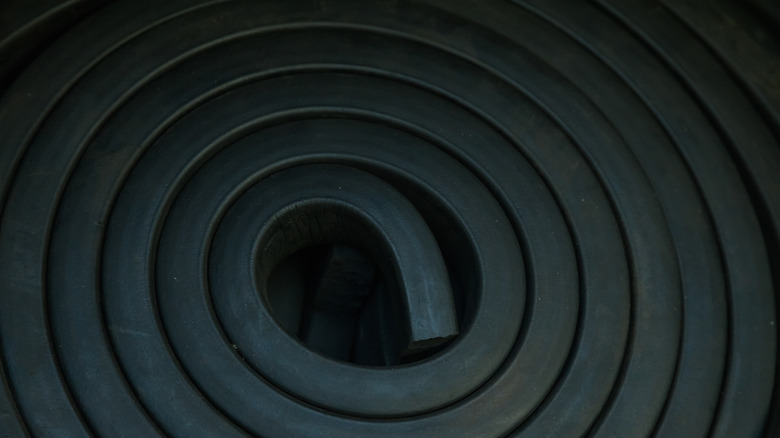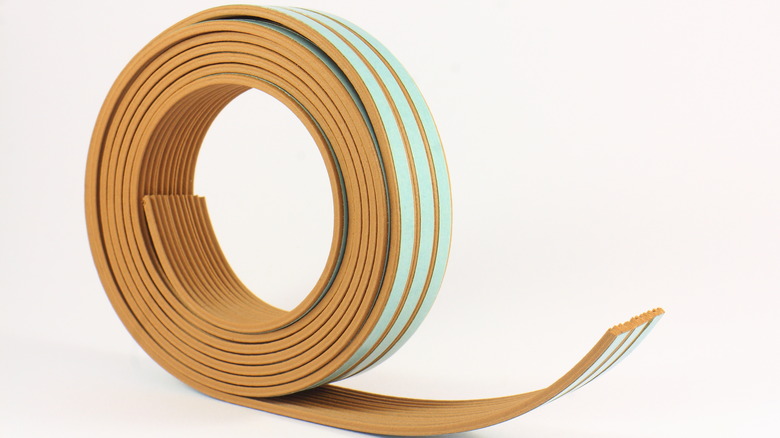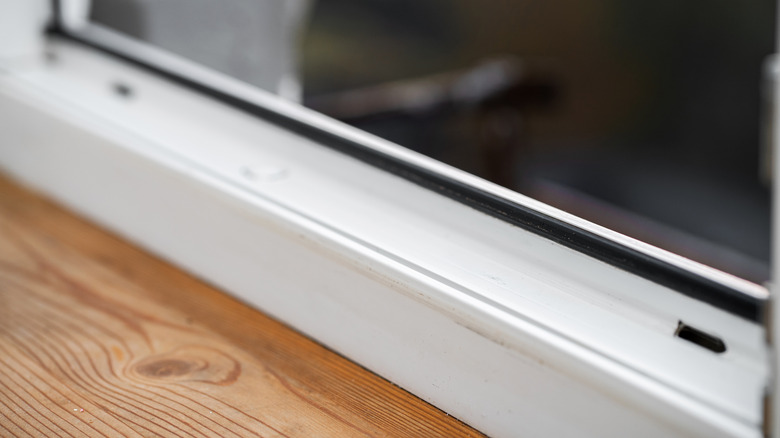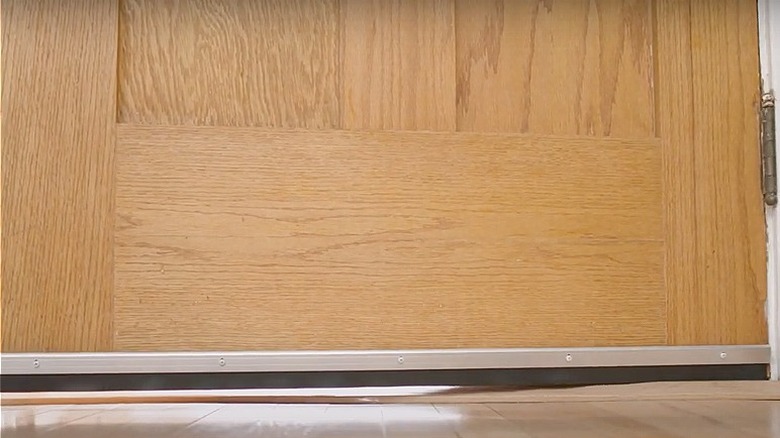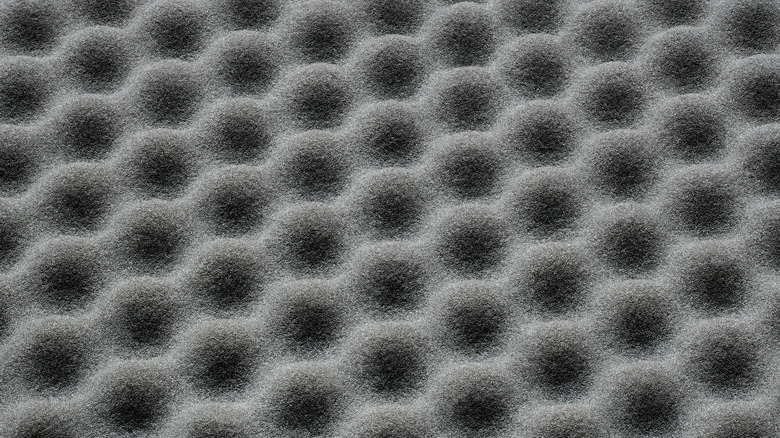The Best Way To Soundproof A Door Effectively
Whether you're a YouTube content creator, a singer or just someone who needs some peace and quiet, the topic of soundproofing will likely come up at some point. Especially since the pandemic, with more people working from home office spaces, the need for good soundproofing has come to the forefront for many homeowners. More often than not, people end up soundproofing a room and forget to do the same to the door –– which is where the most sound comes in and out.
To completely soundproof a door requires plenty of alterations to the door frame you already have, not to mention labor-intensive construction, according to the experts at the Soundproofing Company. The weight of both the door and its assembly can go from 300 to 500 pounds. Not to mention how much the whole process will cost.
To soundproof a door by yourself, you'll first need to examine how and where sound is getting into the room. After that, you'll choose the best way to block noise –– this is going to be determined by your budget, experience in home improvement, and the source of your problem. So, how do you, an unskilled professional on a budget, soundproof a door by yourself? That's what we're here to tell you.
Add soundproofing rubber to the door perimeter
This method will most likely be your go-to if space around your door is the issue, and you're just getting started in the home improvement world. Soundproofing rubber is usually a denser form of neoprene, and you can use it to soundproof the area around your door. Trademark Soundproofing advises that if your door has molding around it already, then you'll have to pry it off. Then, add the soundproofing rubber around the edges of the door.
Add acoustical caulk or any insulating sealant to fill in small gaps and cracks if you want to add even more sound protection. If you're not sure where the cracks are, turn off all lights inside the room and watch where light comes in from outside. Acoustic caulk is pretty inexpensive and does a wonderful job at reducing external sound and increasing sound insulation in a room by up to 15 percent just by using it to cover edges and fill up crevices, gaps, and holes. If you do not have a caulking gun, check out our earlier articles on how to caulk if you don't have a caulking gun.
Add weatherstripping to your door
As the name implies, weather stripping is something that you use on exterior doors to help keep the weather out. Anyone who has ever had a door wear out knows quite well how rain can get in under the door, not to mention copious amounts of bugs. Constellation Blog writes that there are several types of weather stripping, including V-strips and foam tape.
Weatherstripping also helps keep room temperatures regulated, because if your exterior door has a gap underneath, rest assured it won't just be weather elements, insects, and other pests making their way in. It will also be your precious heat or air conditioning seeping out, leading to energy inefficiencies and by default, higher bills. Still, another thing you can count on weather stripping to help you with is noise. Yes, that's right, we're not pulling your leg. Weatherstripping does help reduce noise, says Soundproofly.
If you're going to put up soundproofing rubber, you may also want to fill in the gaps between the door and the doorframe. One of the easiest ways to do this is to use weatherstripping, most commonly used to insulate doors and windows from the elements. Basic weatherstripping tends to degrade over time, but you can buy varieties of higher quality for long-term soundproofing. Also, when you use weatherstripping around your door, remember to apply the right amount of pressure. This pressure is what allows an airtight soundproof door to seal correctly and stop noise.
Add a door gasket
A door gasket is mainly known as the lining that goes around your refrigeration equipment doors to keep airflow accurate. In cold equipment, like refrigerators, freezers, and walk-ins, the gasket is rubber and lines the entire door to keep cold air in and not-cold air out. Their most basic function is to create a tight seal when the equipment door is closed. If you need one of those, Maytag Replacement Parts writes that you could always get one starting from $320 to $500.
Door gaskets for soundproofing are a little more expensive, so this is the method you want to use if you want a step up in quality from weatherstripping. Much like weatherstripping, a door gasket helps fill in the gaps between the door and the door frame. Door gaskets attach permanently to the top and sides of the door jamb to provide good quality, long-lasting seal. And exactly like soundproofing rubber, they often consist of high-quality neoprene. You can even purchase door gaskets that are adjustable, something which many people prefer, states Overtone Acoustics. Since doors sometimes warp or are just not perfectly square, being able to adjust your gasket to get the best fit is a helpful feature. If you don't think you can do this yourself, have no fear!
Add a door sweep underneath the door
Door sweeps are not only useful for protecting your home from the elements, as well as copious amounts of dust and insects, but they also help dampen sound, says Soundproof Central. This step is important for closing the gap that exists at the bottom of many doors. You can add as many gaskets and panels as you want to your door, but if there's still a gap at the bottom, enormous amounts of sound will be leaking through. To prevent this, simply install a door sweep on the bottom of the door to close the offending gap and stop sound waves. Soundproof door sweeps take some work to install — you'll need a drill, some screws, and plenty of patience — but the immense improvement in soundproofing is a solid enough reward.
You can even install an automatic door sweep. This kind of door sweep, Trademark Soundproofing writes, has a concealed flat-spring mechanism to control the sweep's movement. The sweep stays just above the level of the floor while the door is open, but drops down when the door is closed to form a tight, soundproof seal with the floor. This allows for a very tight seal as the rubber actually pushes down onto the floor, it also prevents the seal from dragging on the floor during the closure; thereby, protecting your floor surface, and preventing the seal from wearing out quickly.
Use a soundproof blanket
Sound-proof blankets are made from materials that act as sound absorbers. The thickness of the blanket is also often key. Even the way the blanket is stitched can help to deaden the sound. Though they can be costly, soundproof blankets, which are typically fiberglass, absorb sound very well, and are easy to install. Put some suction hooks on the back of your door and hang the soundproof blanket on them. If you're not really looking for a permanent solution, soundproof blankets tend to work best because you can hang them when you need them and take them down when you don't.
These blankets are great for rooms where there are a lot of hard surfaces without much furniture. When sound is able to freely bounce around from floor to walls to ceiling and back, the sound is amplified by quite a lot. Adding a soundproofing blanket to at least one of these hard surfaces is a sure-fire way to add a "speed bump" for the sound. It will slow down sound waves by ensuring that they can't bounce around and get any louder. You can also choose to get a window noise control blanket, as suggested by Vocal Booth To Go.

